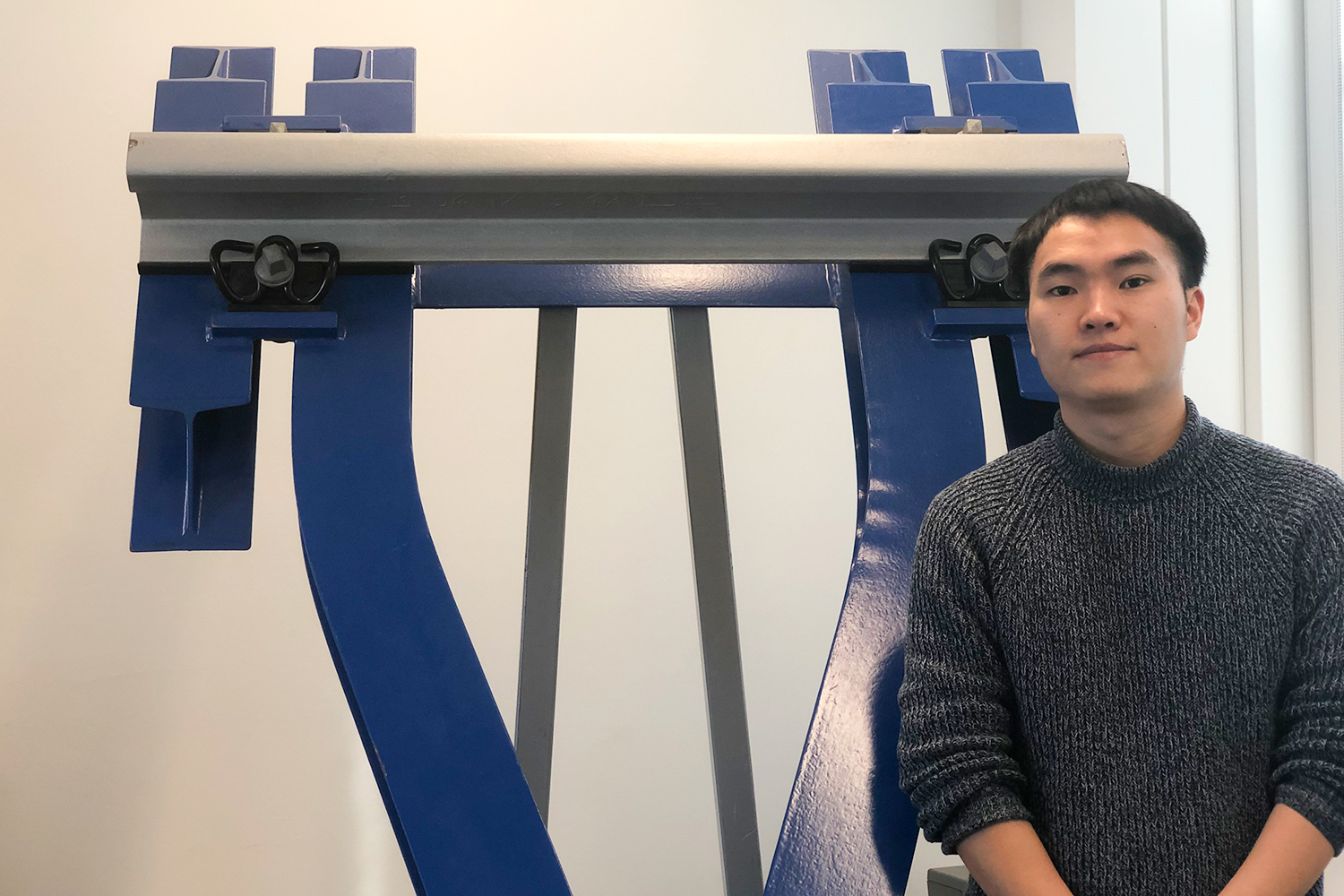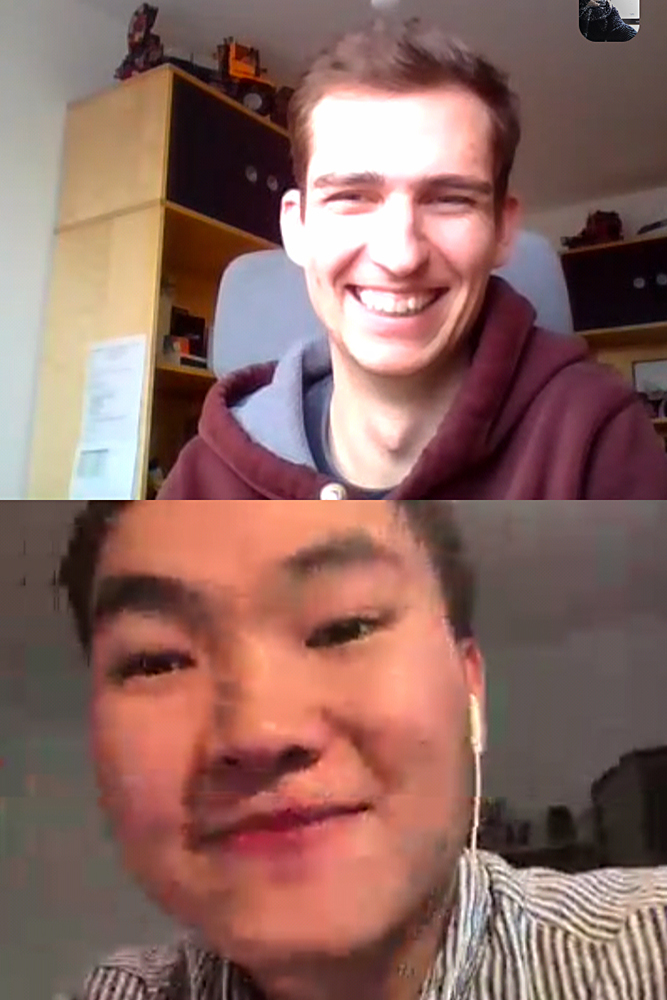From Shanghai directly to the home office An interview with Rudong Yang and Jan Peter Heemsoth from the Institute for Transport, Railway Construction and Operation
When he came to Braunschweig from China in the early January, the situation concerning the coronavirus in his home country was slowly getting worse. Rudong Yang from Tongji University, Shanghai, was looking forward to working with colleagues from the Institute for Transport, Railway Construction and Operation (IVE) to promote the international research project EAST-Cities in the Core Research Area “Future City”. Now he – like many scientific researchers from TU Braunschweig – is doing his research from his home office. An interview with Rudong Yang and Jan Peter Heemsoth from the Institute of Transport.

Rudong Yang in front of a “lifelike” model of a so-called Y-threshold in the seminar room of the IVE. The photo was taken at the beginning of his stay in Braunschweig. Picture credits: IVE/TU Braunschweig
Mr. Yang, you came to Germany in January for the “EAST Cities” research project. How do you feel right now? How is it for you to be in Braunschweig?
Rudong Yang: I feel fine. My colleagues from the institute have been very friendly to me and invited me to join them. I can’t speak German, but everyone in the team speaks English with me. Now, of course, I stay at home to protect myself. I am a bit afraid to go out.
How do you work at the moment? Can you continue your research from your home office?
Jan Peter Heemsoth: It’s actually a bit more difficult than in the institute, especially communication. It’s different if you are sitting directly opposite each other or standing and talking to each other than doing it via Skype or other tools. And the “Flurfunk” is missing.
How do you communicate with each other?

Interviews in times of Corona. Picture credits: Bianca Loschinsky/TU Braunschweig
Jan Peter Heemsoth: Rudong Yang is a kind of “middleperson” in the Department of Transportation Management Engineering of Professor Ruihua Xu at Tongji University. He translates all our ideas and results into Chinese and vice versa into English for us. So all communication works mainly through Rudong.
Rudong Yang: Most of the communication is mainly via e-mail. But of course I also came to Germany to intensify communication, to make it more efficient and thus to be able to work on the project better. Also through my participation in the routine meetings we want to support the progress of the project.
How can further work on the project be guaranteed in view of the Corona crisis?
Rudong Yang: Of course we will continue the cooperation between our institutes. The teams at Tongji University and TU Braunschweig are used to working with each other even over distance. Unfortunately the planned visit of the Chinese partners here in Braunschweig cannot take place. The meeting would of course have been good to get to know the respective research situation better.
During the visit the Memorandum of Understanding for the EAST-Cities project should also have been signed.
Jan Peter Heemsoth: It has been signed in the meantime, but in a different way: digitally via e-mail and Skype. But unfortunately the important face-to-face meetings and the planned research week had to be postponed.
Which tools do you use now to continue your work?
Rudon Yang: The German partners mainly use the classic email, also because of the time difference between Braunschweig and Shanghai. As a Chinese person I use wechat a lot, because it is the easiest way for the communication.
In our project we are at the beginning of phase 2. Next, I think maybe we will cooperate in developing some specific software or interface to support this subproject.
In your EAST-Cities sub-project you are doing research on mobility. What exactly is it about?
Jan Peter Heemsoth: In the sub-project mobility, together with Professor Thomas Vietor’s Institute of Design Technology, we are mainly looking at the status quo of traffic in the urban region of Qingdao in the eastern Chinese province of Shandong, which was selected as research area. We are investigating the current state of mobility there. In the next phase, we want to find out whether it is possible to automatically derive a mobility concept by dividing a city into grid squares and assigning possible requirements – such as number of inhabitants and commuters – to these grid squares.
In concrete terms: To what extent is it possible to impose a mobility concept on a city through automation or algorithms? We are not restricted to bus, subway and urban railway systems, but first of all we want to look freely in all directions to see which mobility concepts and carriers are generated from this algorithm for which connections. This is the big goal for the next four years, if the project continues to receive funding from September onwards.
How do the various sub-projects now work together in this new situation?
Jan Peter Heemsoth: We are currently in the process of writing the proposal for the extension of the project. We hope that all reviewers will keep an eye on the current situation.
Communication with China has always been digital and has always worked very well. We had the advantage that we could work on the project around the clock. When we have finished work in Braunschweig, our Chinese colleagues have almost got up again.
Mr Yang, how long do you plan to stay in Braunschweig?
I will spend a total of six months in Braunschweig. I plan to fly back to Shanghai at the beginning of July – if the situation allows and the planes are flying normally again. In spite of all adversities, I am very happy that I have been given the opportunity to work on the project here in Braunschweig.
